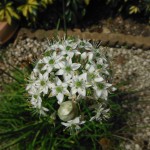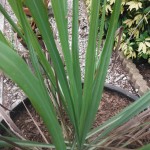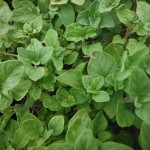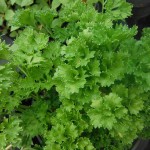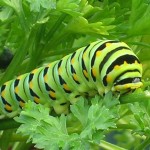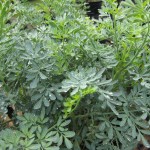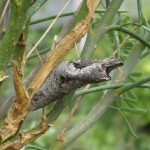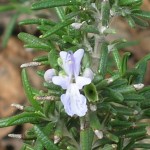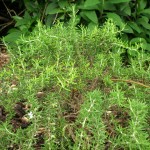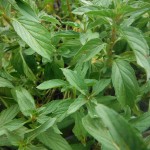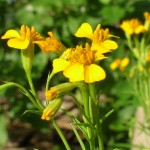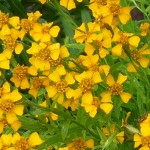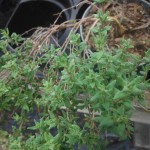Heat-Defying Herbs
Just as most of us wilt during Florida’s long, humid summer, so do many vegetables which simply can’t hold up to hot nights and persistent rains. But not all is lost. There are many herbs that are adapted to beating the heat. A leisurely tour of Richard Lyons’ Nursery will demonstrate a number of the species that are ready to diversify your meal planning and take you deliciously through the dog days.
Garlic Chives (Allium tuberosum): Also known as Kow-choi or Chinese Chives, this onion relative is a very desirable plant for the summer garden. It excels as a flavoring agent for those who like a mild version of garlic; its delicate taste can be detected in many Asian dishes. Both leaves and flowers can be used as seasoning. But Garlic Chives also make a nice ornamental contribution to the herb garden, whether in small groups or as a ground cover. The 2′ x 2′ plants look like neither garlic nor onions, but instead feature flat, broad leaves. At flowering time, fragrant white blooms appear on stalks projecting above the leaves.
Lemon Grass (Cymbopogon citratus): Though commonly known as West Indian Lemon Grass, this popular herb is native to maritime Southeast Asia. It grows in dense clumps capable of reaching 6′ high and about 4′ wide. Its blue-green strappy leaves, which droop gracefully at the tips, emit a citrusy aroma when crushed. The leaves are also used widely — either fresh or dried and powdered — to flavor curries, teas and soups, as well as meat and seafood dishes. Lemon Grass oil contains a number of useful compounds, including the mosquito repellent, citronella. Plant this year-round herb in bright light in moist soil.
Oregano (Origanum vulgare): Oregano, an herbaceous perennial native to warmer regions from Europe to Asia, is a member of the mint family and is closely related to sweet marjorum. It can reach over 32″ high, but usually stays under 20″ and spreads by rhizomes. The dark green, oval leaves of Oregano are aromatic and tasty. They can be cooked fresh or dried for longer-term use. The plant produces white to pink to purple edible flowers on upright stalks, but the leaves taste best when harvested just before bloom time. The multiple cultivars of Oregano possess distinct tastes.
Parsley (Petroselinum crispum): Parsley, a biennial aromatic plant native to both the African and European sides of the Mediterranean, has many culinary roles: herb, spice, vegetable. It is also a butterfly attractant. It generally grows in clumps about a foot tall by a foot or more wide. Parsley’s bright green triangular leaves are finely divided into flat or curly leaflets which are harvestable even in climates where wintertime nights hit the low-20s. One of the three varieties of parsley produces edible roots. It is also popular as an ornamental plant in gardens, where it can be incorporated in window boxes or used in the ground as an edging material.
Rue (Ruta graveolens): Like most people, you probably find yourself in need of a witch-repellent from time to time. Meet Ruta graveolens. From the Middle Ages on, this native of southern Europe was valued as an essential tool in the struggle against witches, so it was integrated into many spells — perhaps even by the Wizard of Id. In more recent times, Rue has been used both to flavor foods and to add fragrance to cosmetics and soaps, and it also has many medicinal applications. Ironically, its bluish leaves, while still on the shrub, emit an unpleasant odor, so it’s best to locate this hardy plant at some distance from your house.
Rosemary (Rosmarinus officinalis): Here’s one of many herbs belonging to the mint family. Rosemary is a woody perennial plant that matures to about 6′ high and 4-5′ wide. It is at home in poor, dry soils. Native to Mediterranean lands, it produces strongly fragrant, needle-like leaves and semi-tubular flowers that vary from white to pink to purple to blue. Its astringent leaves are particularly popular when cooked with fatty foods, but are also often used to dress roasts. Rosemary is also said to enhance memory, a quality which may help you remember that you can prune it following flowering to encourage denser growth.
Spearmint (Mentha spicata): Spearmint has been cultivated for so many centuries that no one knows its exact native range, though experts think it was southwest Asia and Europe. This herb usually matures to 2′ high and 2′ wide and spreads via rhizomes, and it produces white to lavender flowers on terminal spikes. Its serrated leaves emit a very striking scent when crushed. Spearmint has long been used to flavor teas, cooked foods, salads, candies and toothpaste. It is happy in moist soils and should be grown in full sun to partial shade. It is amenable to shearing to remove spent flower spikes and to encourage new growth.
Tarragon (Artemisia dracunculus var. sativa): The aromatic leaves of this subspecies of Artemisia are cultivated for use as a culinary herb. The plant comes in many forms, each imparting a specific flavor. It is native from the Caspian Sea area to central and eastern Europe, including Siberia! Tarragon matures up to 5′ high, but usually shorter, and spreads by rhizomes. Flowers are yellow-green, but the plant does not always produce blooms. Its lanceolate, i.e., narrow and pointed, glossy leaves are used fresh or dried to flavor vegetables, meats, fish, sauces and eggs. Tarragon prefers well-drained soils.
Thyme (Thymus vulgaris): Another representative of the mint family, Thyme is a bushy, woody evergreen shrub native to southern Europe. It grows 6-12″ high and about 16″ wide and features highly-aromatic, small, gray-green leaves. Its semi-tubular flowers are pink to pale purple. Thyme favors full-sun exposures and easily tolerates dry, rocky, shallow soils. The leaves are most aromatic just before bloom time, and can be used fresh or dried to complement the flavor of meat and fish dishes, sauces, soups and stews. Thyme also has many cultivars created for its use as an ornamental plant in the garden or in pots indoors.

